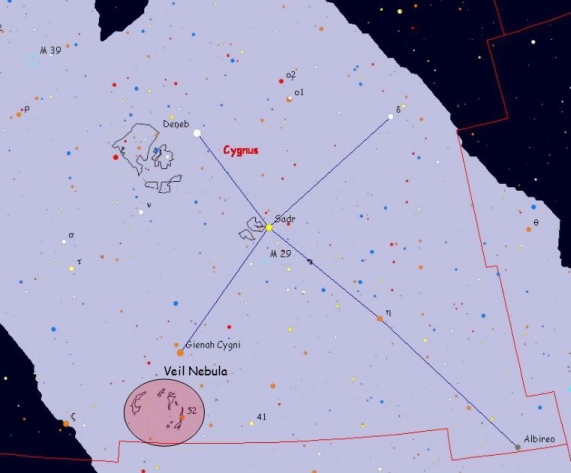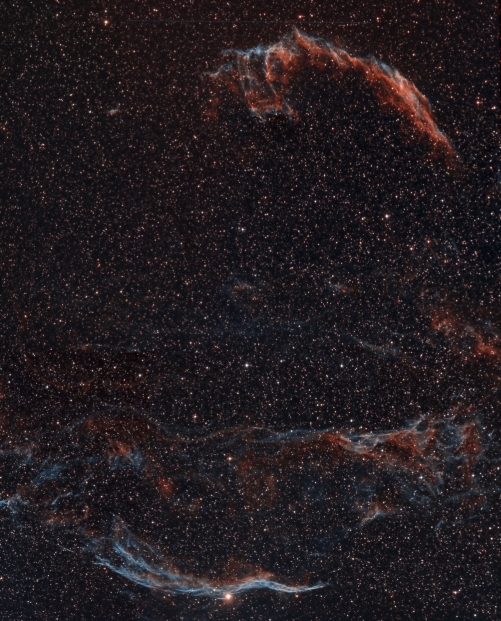The Veil Nebula
The Veil Nebula is a large but faint supernova remnant of a star which exploded 5000 to 8000 years ago about 1,500 light years from Earth. This nebula is located in the constellation Cygnus (the Swan) and lies a few degrees to the south of the star Epsilon Cygni, also known as Gienah. Over time, the remnants have expanded to cover an area about 3 degrees in diameter (for comparison, the moon is about 0.5 degrees in diameter). The thin filamentous structure of the Veil Nebula results from shock waves expanding from the supernova explosion being so thin that the shell is visible only when viewed exactly edge-on.
Location of the Veil Nebula in Cygnus, the Swan

Map made with Cartes du Ciel
The nebula was discovered on 1784 by William Herschel who described the eastern and western ends of the nebula.
Pickering's Triangle was identified in 1904 by Williamina Fleming in photographic images at Harvard Observatory but credited to her supervisor Edward Pickering.
In modern usage, the names Veil Nebula, Cirrus Nebula, and Filamentary Nebula generally refer to all the visible structure of the Cygnus Loop (radio source W78, or Sharpless 103).
There are three main components in this image (east is at the top, north to the right):
The Western Veil (also known as Caldwell 34, Witch's Broom, Finger of God, or Filamentary Nebula) is composed of NGC 6960 near the foreground star 52 Cygni. 52 Cygni is located much closer to Earth (206 light years) and is not physically associated with the Western Veil;
The Eastern Veil (Caldwell 33) whose brightest area is NGC 6992;
Pickering's Triangle in the north central edge of the loop, but also visible in the central area of the loop.
In addition, NGC 6974 and NGC 6979 are faint patches of nebulosity on the northern edge between the Eastern Veil and Pickering's Triangle.
| Telescope | Takahashi FSQ-106EDX III f/5.0 (530 mm focal length) captured at 2.1 arcsec/pixel |
| Mount | Celestron CGEM modified with HyperTuning and Telescope Drive Master |
| Camera | SBIG STT-8300/AO-8T cooled to -35 C with a self-guiding FW8G-STT filter wheel (Baader 7nm Hα filter, 8nm OIII, and 8.5nm SII) |
| Acquisition Dates | 6/29/2014 to 10/11/2014 at the Barking Spider Observatory |
| Exposure |
|
| Software | Image acquisition and guiding on a Macintosh Airbook using Equinox Image. Image processing (calibration and registration) was performed using Pixinsight. Segment merging and the RGB image was created using Pixinsight following tutorials by Kayron Mercieca with the narrowband data blended as follows: R = SII + (0.8*Hα), G = (0.075*Hα) + OIII and B = OIII. |
The image below is a six segment mosaic constructed using Pixinsight. Click on image full full size (very very large)

